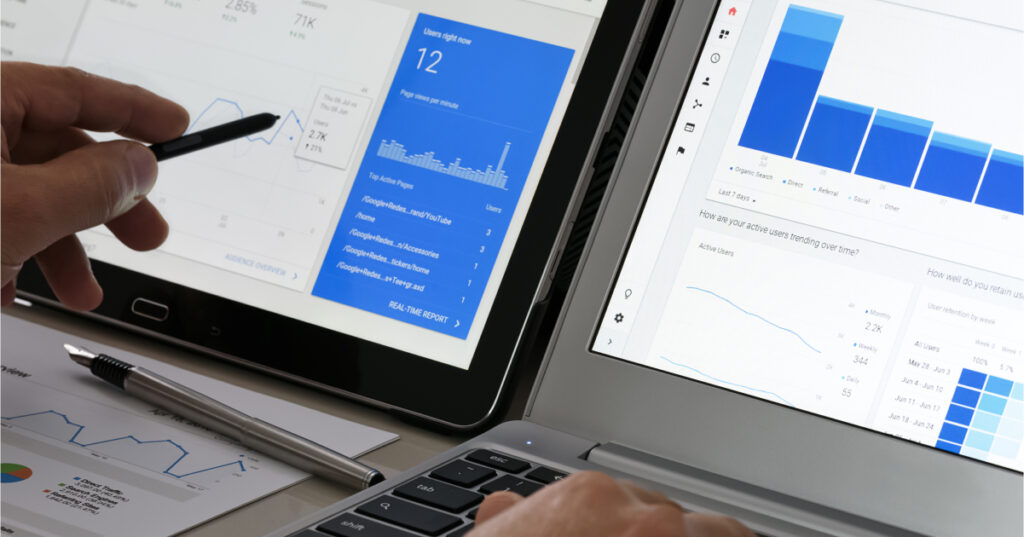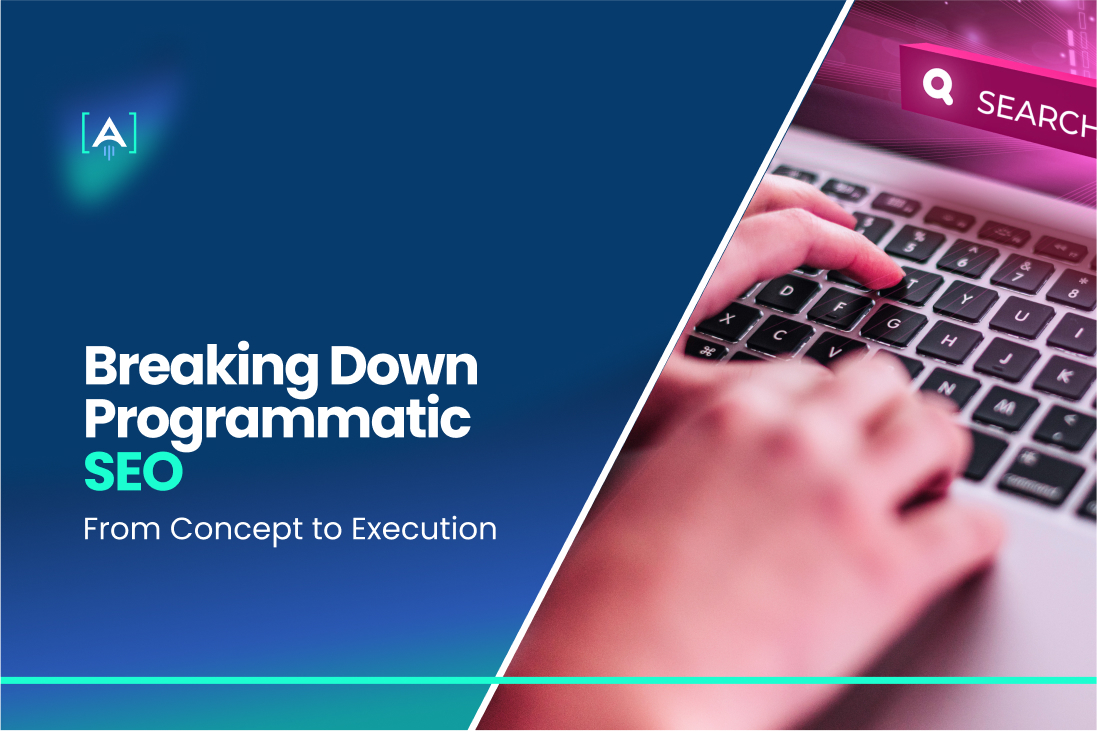A solid online presence is crucial for brands today.
Imagine if you could up your game without spending endless hours.
Crafting top-notch, long-form content for your website is the key strategy to rank high on Google.
One exciting trend to do is Programmatic search engine optimization (pSEO).
This advanced seo technique automates and scales the content creation process, allowing you to target a wide range of search queries efficiently.
Partnering with an SEO agency that understands Programmatic SEO can further amplify your results.
In this blog post, we’ll answer the question “What is Programmatic SEO?”, its potential, its importance and benefits, and how you can use it.
Understanding Programmatic SEO

While we are familiar with international SEO and natural language processing SEO, what is Programmatic SEO and how does it differ?
Programmatic SEO is a tool that automates the creation of web pages using code.
The magic happens when it targets keyword variations and groups for landing pages.
This means your website is speaking the language of search engines, making it more likely to pop up when users are looking for what you offer.
Let’s consider a real estate business as an example.
Programmatic SEO can dynamically generate pages based on constantly updating real estate listings.
For instance, your website might create pages for specific types of properties like “luxury condos in Manhattan” or “beachfront homes in Malibu.”
These pages will update regularly with new listings, prices, and features, ensuring your site ranks well for these specific, frequently changing search terms.
This showcases how programmatic SEO uses fresh, constantly updated data sources, greatly enhancing your site’s relevance and search engine performance.
Importance of Programmatic SEO

Programmatic SEO boosts your website, providing organic reach and visibility.
Let’s explore why Programmatic SEO isn’t just a tool:
Search Spotlight on Your Business: Each category, product, or service on your website must be spotlighted so that users find your services easily. Programmatic SEO saves you time and energy doing this automatically based on the dataset.
Efficiency Overload: Businesses using Programmatic SEO experience a surge in efficiency. It automates content creation, saving valuable time and resources.
Organic Traffic and High Ranking: Programmatic SEO strategically tailors your content to specific keywords. It creates pages that resonate with what users are searching for. As search engines recognize this relevance, your pages climb the organic ranking ladder.
Enhancing User Experience: pSEO ensures users find exactly what they need. It allocates content that guides users through your website.
Top Benefits of Programmatic SEO

Now that you understand what Programmatic SEO is, it’s clear that it involves SEO automation to generate numerous pages quickly
Here are some tangible benefits of pSEO.
Future-Proofing Businesses: The digital landscape is constantly shifting, but you’re always one step ahead with programmatic SEO. Its automated approach adapts to algorithm changes and future SEO trends, ensuring your website remains visible.
Building Useful Links: Programmatic SEO organically attracts high-quality backlinks by focusing on valuable, user-centric content.
It ensures your pages are substantial, useful, and worth linking to. Your website becomes a trusted resource, naturally drawing in links that boost your authority and search engine credibility.
Redirecting Effort Productively: Manual updates for SEO improvements can drain valuable human resources. Programmatic SEO integrates with other tools like affiliate tracking platforms and automation centers.
Automatically generating programmatic SEO pages frees your team to focus their time and energy on more strategic and impactful tasks.
Additionally, implementing a technical SEO audit can help identify areas for improvement, ensuring that your programmatic approach is practical and aligned with best practices.
Challenges of Programmatic SEO

While programmatic SEO is a powerful engine for organic growth, it’s not always smooth.
Here are some potential challenges you can face:
Suitability for Different Business Models: Not every business fits this automated approach perfectly. Websites with limited target audiences or particular content needs might find manual control offers greater precision. Additionally, incorporating schema markup SEO into a programmatic setup can be complex and may require extra effort to ensure it aligns with your unique business needs. Be honest about your niche and goals.
Indexing Challenges: Due to the sheer volume of pages, Google’s crawl budget may struggle to index them all. You can solve this by building an XML Sitemap, emphasizing internal links, reducing errors, and ensuring search crawlers navigate your site efficiently.
Content Craving: As programmatic SEO generates an increased volume of web pages, the maintenance demands grow. Programmatic SEO requires constant nurturing to ensure the quality and relevance of your content. Prepare to invest in ongoing optimization and editorial oversight.
Duplicate Content Dilemma: Programmatic SEO may lead to duplicated content across pages, affecting Google’s preference for uniqueness. Mitigate this by rewriting content manually or using AI in SEO. AI-powered tools to ensure each page offers distinct value, preventing ranking difficulties.
Impact of Technological Shifts: The fast-paced evolution of technology, particularly the rise of generative AI, introduces uncertainties to programmatic SEO. Adapting to these shifts becomes challenging, as staying updated requires continuous monitoring and adjustment.
Keyword Repetition: Using modifiers in keyword variations may accidentally lead to targeting similar search terms across multiple pages.
To avoid confusion for search crawlers, consider merging similar content pieces into one comprehensive resource, preventing lower rankings or unindexed pages.
When to Opt for Programmatic SEO

Exploring what Programmatic SEO is and what pros and cons it has, you may still wonder when businesses need to apply it.
Programmatic SEO works best when:
- Your Content Tells a Clear Story: If your website has a consistent theme, programmatic SEO can effortlessly create pages that fit your story.
- Search Volume is High: The more searches, the more eyes on your content. So, it’s perfect for topics that many people are curious about. By leveraging AI overviews, a significant advance in search tech, you can efficiently identify and target popular subjects, ensuring your content aligns with high search volumes and attracts substantial traffic.
- Planning to Publish a Lot: If you plan to flood your website with content – articles, product pages, or guides – programmatic SEO can create them quickly, saving you time and effort.
Stop and Think Before You Leap
Does your content naturally fit into a broader category with related keywords, or is it more scattered and individual?
Will the number of people searching for your target keywords justify the effort of creating many pages?
Are the keywords competitive enough to require programmatic SEO, or could manual optimization be more effective?
Do you genuinely need a vast amount of new content, or would targeted manual efforts be more efficient?
Executing Programmatic SEO: A Step-by-Step Guide

Creating programmatic content might seem daunting but fear not.
This step-by-step approach will guide you to make Programmatic SEO accessible and actionable for you.
Step 1: Set Clear Goals
Expectations from Programmatic SEO: Every content you create must have a clear goal to guide your strategy. More visitors, more sign-ups, or maybe better rankings?
Creating Programmatic SEO pages is a great way to attract potential customers and showcase your brand. Set up the right pathways for customers to learn more so you can make the most of the extra attention and awareness.
Research your niche comprehensively: If you don’t know where to start, consider your audience’s interests. How to apply your product or service, the locations you serve, the integrations you provide, and any valuable templates.
Analyze Competitors: Observe competitors’ page formats and layouts to draw inspiration for your own. Once you’ve done that, broaden your research.
Step 2: Research Keywords
Jot Down Keywords: Think of relevant keywords that people might type into a search engine to find your website.
Think about the problems your website solves. Imagine you’re someone looking for what you offer—what words would you use?
You can use a keyword research tool:
- Moz Keyword Explorer
- Semrush’s Keyword Magic Tool
- Ahref’s Keyword Generator
- WordStream
- Google Keyword Planner
Identify Modifiers and Related Terms: Modifiers are extra words that target specific searches when added to your main keywords.
Consider Long-Tail Keywords: They’re specific and have less competition, bringing in niche audiences.
Consider a travel and tourism website.
This type of site can benefit from using specific long-tail keywords like “budget-friendly hotels in Paris” or “best hiking trails in Colorado.”
These phrases are more targeted than general terms like “hotels” or “hiking trails.”
For a site offering travel tips, using modifiers like “eco-friendly travel in Southeast Asia” or “family-friendly activities in Florida” can attract a specific audience.
Additionally, associated terms like “travel visa guidelines for Europe” can broaden the content and cater to a wider range of traveler needs.
Step 3: Create Valuable Content
Plan the content structure: Develop a clear structure for your content using the selected keywords. Divide it into sections or titles that match the target keyword. Search engines will understand your content, and users will find information more easily. You must go beyond just securing a spot in search results. To truly benefit users, focus on delivering high-quality content that meets their needs. This involves creating content that ranks well and demonstrates Google E-E-A-T.
Add Engaging Elements: Use multimedia elements like text, images, and videos for visual appeal. Include personal anecdotes or storytelling to make the content relatable.
Optimize On-Page Elements: On-page elements are headers, meta tags, and image alt text. Optimize meta tags naturally, making them persuasive. Include keywords in headers for a clear structure. Optimize image alt text for accessibility and visibility in image search results.
Incorporate Internal and External Links: Add internal links to guide users to your landing page template or relevant articles, improving search engine indexing. Include external links for added authority and credibility, providing readers with additional resources.
Step 4: Determining Scalability and Choosing the Right CMS
Understanding Scalability is essential for seamlessly handling expanding content volume, search traffic, and evolving SEO strategies.
Factors to Consider for Scalability:
- Traffic Volume: Anticipate current and future traffic levels to ensure the Content Management System (CMS) can handle the load efficiently.
- Content Growth: Evaluate the expected rate of content addition and the CMS’s capacity to manage it smoothly.
- Infrastructure: Assess the availability of resources for scaling, such as cloud-based solutions or load-balancing capabilities.
- Integrations: Consider the need to integrate with other tools and systems, ensuring the CMS can handle these connections effectively.
When choosing the Right CMS for Programmatic SEO, consider the following:
- SEO Features: Native SEO capabilities for metadata optimization, sitemap generation, URL structure control, and integration with SEO tools.
- API Access: Ability to interact with the CMS programmatically through APIs for automation and data exchange.
- Performance: Website speed optimization is crucial for fast loading speeds and a focus on performance optimization to enhance user experience and SEO.
- Scalability: Ability to handle content, traffic, and functionality growth without compromising performance.
- Security: Robust security measures to protect against vulnerabilities and data breaches.
- Support and Community: Availability of documentation, tutorials, and a supportive community for troubleshooting and assistance.
Step 5: Develop Content Templates and Sourcing Data
Templates are pre-made outlines for your content, with blank spaces like “insert product name here” or “fill in this benefit.”
Data is all relevant information, like product descriptions, customer reviews, or industry trends.
The machine takes these ingredients, fills in the blanks, and pops out unique, informative pages.
Using different templates and data, you can make many pages targeted to specific searches.
But remember, these ingredients need to be fresh, clear, and engaging.
So, the key is to:
- Gather high-quality, relevant data.
- Build flexible templates that highlight the data.
- Keep it exciting and optimized for search engines.
How to Collect and Manage Data for Programmatic SEO
Let’s explore some methods for data collection:
1. Internal Treasure Trove:
- Product Databases: Product names, descriptions, images, and specifications are essential for building rich product pages.
- Customer Relationship Management (CRM): Customer demographics, purchase history, and browsing behavior offer valuable insights for tailoring content and recommendations.
- Website Analytics: Follow user behavior on your website to understand what content resonates and which pages need an SEO boost.
- Blog Posts and Articles: Repurpose existing content, extracting key data points and insights to enrich new programmatic pages.
2. External Exploration:
Market Research Reports: Industry trends, competitor analysis, and customer sentiment data can inform your content strategy and identify new keyword opportunities.
Public Datasets: Open-source research and industry-specific statistics provide valuable sources of factual information and inspiration.
Here are some public dataset examples;
- Government Databases: Many governments offer open data portals. For example, the U.S. government’s data.gov or the UK’s data.gov.uk provide a wealth of information across various sectors.
- World Bank Data: This offers global development data, useful for international market analysis and trends.
- Google Public Data Explorer: A platform that allows users to explore various datasets, including economic and population data.
- Kaggle Datasets: Popular among data scientists, Kaggle offers datasets on a wide range of topics, from business to science.
- Data.World: A social data platform that provides datasets on various topics, including health, education, and finance.
APIs (Application Programming Interfaces): Connect your SEO tools to external databases and platforms to import relevant data feeds automatically.
3. User-Generated Content:
- Reviews and Testimonials: Showcase real-world experiences and build trust with potential customers.
- Social Media Interactions: Analyze comments, shares, and hashtags to understand user interests and trending topics.
- Surveys and Polls: Gather insights from your target audience, tailoring your content to their needs and concerns.
Data Management Mastery:
- Ensure consistency and accuracy by removing errors, formatting data uniformly, and addressing missing values.
- Create a clear structure for storing and accessing your data, making retrieving relevant information for specific projects easy.
- Regularly update and refresh data to avoid inaccurate content and missed opportunities.
Once you’ve done these essential steps, move to the next level.
Keep an Eye on Performance
Once your pages are live, monitor how well they’re doing.
Are they attracting visitors? Are they ranking higher? Regularly check and adjust as needed.
This helps search engines understand and love your content.
Avoid Content Duplication
Duplicate content confuses search engines and harms your rankings.
Prevent content duplication by ensuring each page on your website offers unique value.
Prioritize User Experience
Create a user-friendly interface, easy navigation, and engaging content. Don’t forget about SEO mobile optimization.
A positive user experience boosts your site’s credibility and encourages visitors to explore further.
Testing and Iterating Strategies
Don’t set and forget.
Programmatic SEO is about evolution, not stagnation.
Continuously test different strategies, see what works best, and keep improving.
Programmatic SEO Examples

Let’s explore what Programmatic SEO is for businesses and hw they implement it SEO to optimize their online presence.
Zapier
Zapier employs programmatic SEO to create and position pages for its offered integrations.
It focuses on keywords using the structure <App Name> Integrations.
<App Name> is the modifier, and Integrations is the main term.
Examples include:
- Integrations with Google Sheets
- Integrations with HubSpot
- Integrations with Landing
Every Zapier page following this formula shares a uniform template, with only the copy and logo changing to match the users’ search queries and the specific app name.
Traffic generated from programmatic SEO pages (277K) accounts for approximately 3% of the total organic traffic to Zapier.com (9.1M).
While this is a smaller proportion of the total traffic, it’s still a substantial figure, highlighting the effectiveness of programmatic SEO in driving targeted traffic.
A remarkable 86.4% of Zapier’s organic performance from January 22-24, represented by 57,689 out of 66,780, is due to the success of programmatic SEO pages.
Performance with Programmatic SEO
Overall Performance
Nomad List
Nomad List is a cool website for digital nomads, helping them find the best places to live and work remotely.
They use Programmatic SEO to make things smooth.
The site collects tons of data every second, giving you a quick idea of where to go.
One cool thing they do is create city pages targeting keywords like “Best Places to Live in [Continent]” or “Cost of Living in [City].”
For instance, their “Cost of Living” page– it just shows data without many words.
We see a smart use of pSEO to help users without making them read a bunch.
Analyzing Nomad List’s SEO performance reveals a significant impact of their programmatic SEO efforts.
The main domain, nomadlist.com, shows robust organic search metrics with 29.8K keywords, bringing in 46.9K in traffic.
Focusing on their subdomain, nomadlist.com/cost-of-living, which employs programmatic SEO, we see it ranks for 3.1K keywords and attracts 6.1K in traffic.
This means the programmatic SEO on the subdomain accounts for approximately 13% of the total traffic of Nomad List.
Overall Performance
Performance with Programmatic SEO
Amazon
Amazon’s programmatic SEO boosts its product pages and categories on Google.
They optimize product pages with keywords that match popular searches.
Category pages are also tailored to rank for broader search terms.
This strategy helps Amazon appear first in Google searches, using data on what customers search and buy.
Performance with Programmatic SEO (Amazon New Releases web page)
Tripadvisor
Tripadvisor identifies many travel-related searches and then uses software to build thousands of pages targeting those specific phrases.
These pages are automatically filled with relevant info like attractions, reviews, and prices, tailored to any search related to travel, hotels, and places.
The result?
Tripadvisor dominates search results, making it the go-to travel guide before every adventure.
Let’s look at an example;
This January, TripAdvisor’s ‘Restaurants’ webpage, boosted by their programmatic SEO efforts, attracted 4.4 million visitors in a month.
Content Relevance in Programmatic SEO

Programmatic SEO churns out pages fast, efficiently, and temptingly.
However, content needs relevance and usefulness.
Here’s why relevance matters:
Attract Search Engines: Google loves fresh, relevant content that precisely answers user queries. Programmatic SEO can generate pages for countless keywords, but only those with quality information will earn search engine favor and get ranked.
Engaged Users: No one wants to stumble upon a page filled with robotic repetition or keyword stuffing. Relevant content provides value, answers questions, and keeps users engaged, boosting dwell time and sending positive signals to search engines.
Long-Term Growth: You can game the system with irrelevant pages for a quick traffic boost, but it’s a shaky foundation. Invest in genuinely helpful content that builds trust and attracts loyal readers for the long term.
Master Programmatic SEO for Impactful Results

Now, you have an understanding what Programmatic SEO is.
It’s a dynamic journey that demands a keen eye on user experience and a commitment to staying ahead of the curve.
While automation is king, always insert a human element.
Prioritize accurate, relevant, and engaging content.
Don’t let your Programmatic SEO robot become a content spammer.
Implementing Programmatic SEO strategies optimally will boost your online presence and attract new customers.
Let your website rank high and stand out for its quality, relevance, and the genuine value it brings to those who explore its pages.

